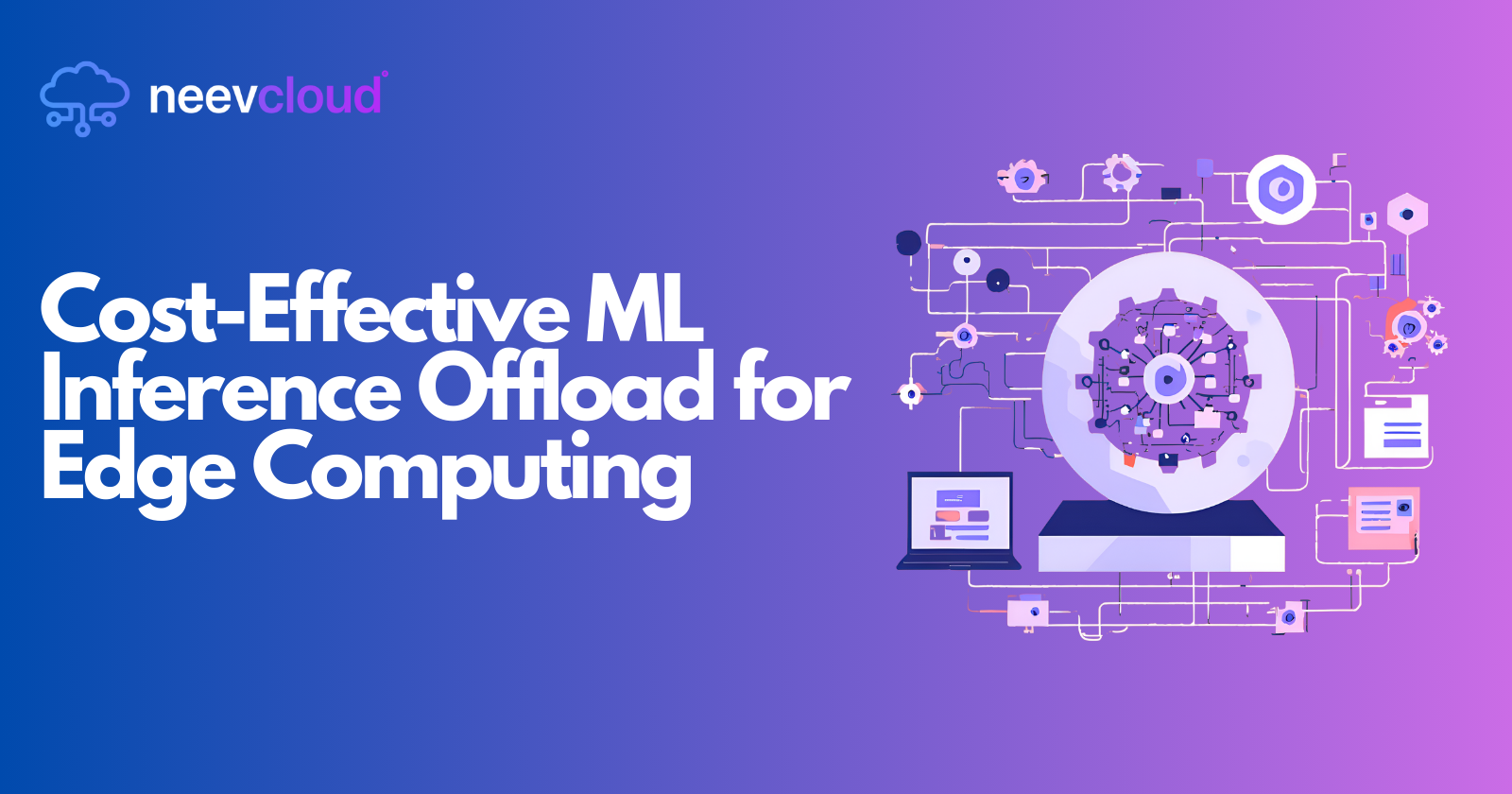Cost-Effective ML Inference Offload for Edge Computing
 Tanvi Ausare
Tanvi Ausare
In the era of rapid technological advancement, edge computing and artificial intelligence (AI) have emerged as pivotal components of the modern digital landscape. As companies increasingly rely on AI-driven systems to enhance operations, improve decision-making, and drive innovation, the ability to deploy machine learning (ML) models at the edge becomes crucial. However, managing cost-effective AI and machine learning inference at the edge presents unique challenges. This is where AI Cloud solutions come into play, offering a powerful combination of cloud machine learning and edge computing to optimize performance while minimizing costs.
What is Edge Computing?
Edge computing refers to processing data closer to its source rather than relying on a centralized cloud server. This approach reduces latency, increases data privacy, and optimizes real-time data processing. By bringing computation closer to the devices or sensors generating data, edge computing enhances the performance of AI-driven applications. It is especially useful in industries like autonomous vehicles, smart cities, healthcare, and industrial IoT.
Why Offload Machine Learning Inference to the Edge?
Offloading ML inference to the edge offers numerous benefits:
Reduced Latency: Real-time applications, such as autonomous driving or robotics, require decisions to be made in milliseconds. Offloading inference to the edge ensures faster response times.
Lower Bandwidth Costs: Transmitting raw data to the cloud for processing can be expensive. Edge computing reduces data transmission needs by processing data locally.
Enhanced Privacy and Security: Sensitive data can be processed locally, minimizing the need to send confidential information over the internet.
Scalability: Edge computing allows organizations to scale their AI solutions without overwhelming central cloud infrastructure, distributing the workload across edge devices.
However, the challenge lies in ensuring that these edge devices are capable of running AI ML models efficiently without incurring significant costs. A hybrid solution that leverages both the AI Cloud and edge devices for inference offloading is key to achieving this balance.
Cost-effective AI Inference Offloading: Key Considerations
To design a cost-effective solution for machine learning inference offloading at the edge, several factors must be considered:
Device Capabilities:
The edge devices must have sufficient computational power to run ML models without compromising performance.
GPUs and specialized accelerators can enhance edge processing capabilities, but they also increase hardware costs.
Devices need to be chosen based on the specific requirements of the ML model and the application.
Model Optimization:
Compressing ML models or utilizing lightweight architectures such as MobileNet or TinyML ensures that models can run efficiently on resource-constrained devices.
Techniques like quantization and pruning reduce the size of models without sacrificing too much accuracy.
Model distillation can also be employed, where a smaller model (student model) is trained to replicate the behavior of a larger, more complex model (teacher model).
Cloud-Edge Synergy:
Hybrid solutions that intelligently offload complex tasks to the AI Cloud while handling simpler inferences on the edge are essential.
For example, edge devices can handle local, time-sensitive tasks while deferring more computationally intensive operations, such as retraining models or complex data processing, to the cloud.
Cost Management:
Choosing cost-effective cloud services for training and deploying ML models is critical. Cloud providers like NeevCloud offer pricing models that optimize costs for workloads that alternate between cloud and edge devices.
Preemptive VM instances, spot instances, and serverless solutions can reduce cloud service expenses.
Data Transfer Optimization:
Minimizing data transfer between the edge and the cloud by processing data locally reduces cloud storage and bandwidth costs.
Advanced data compression techniques and edge AI models help to limit unnecessary data transmissions, further reducing operational costs.
How Cloud Machine Learning Supports Edge AI
Integrating cloud machine learning with edge computing creates a powerful combination that enhances the efficiency and cost-effectiveness of AI inference. Cloud-based platforms offer several key benefits when offloading ML inference to edge devices:
Flexible Resource Allocation:
The cloud can dynamically allocate resources as needed. This flexibility allows the cloud to handle spikes in demand without overburdening the edge devices.
Cloud services, such as NeevCloud AI, allow developers to train and test models using large-scale cloud infrastructure and later deploy them at the edge.
Model Management and Deployment:
Managing multiple ML models for different devices becomes easier with cloud-based platforms. The cloud enables seamless model updates and version control.
Centralized model repositories in the cloud ensure that edge devices always have access to the latest model versions without the need for manual updates.
Real-time Monitoring and Feedback:
Cloud services can continuously monitor edge devices to ensure that models perform as expected. By analyzing data from the edge in real-time, the cloud can identify potential issues such as model drift or underperformance.
Real-time feedback from the cloud allows for retraining or adjusting models to improve accuracy and efficiency at the edge.
Cost Optimization Strategies:
By processing critical, time-sensitive tasks at the edge and delegating resource-heavy computations to the cloud, organizations can reduce hardware costs and extend the lifespan of edge devices.
The cloud can handle large-scale data analytics or retraining that would be too resource-intensive for edge devices. This hybrid approach keeps overall infrastructure costs in check.
Key Use Cases for AI Inference Offloading at the Edge
Several industries benefit from AI inference offloading to the edge, particularly where real-time data processing and decision-making are critical:
Autonomous Vehicles:
Edge devices in vehicles can process data from cameras, lidar, and other sensors in real-time for immediate decision-making.
More complex computations, such as route optimization or fleet management, can be offloaded to the cloud.
Healthcare:
AI-powered diagnostic tools at the edge can analyze medical images or patient data in real-time for quick diagnostics.
Cloud-based systems can handle more comprehensive patient data analysis or medical research, reducing the load on local hardware.
Smart Cities:
AI models deployed on edge devices across smart cities can analyze traffic data, control street lights, or monitor public safety in real-time.
Centralized cloud systems handle city-wide data aggregation, optimization, and large-scale planning tasks.
Industrial IoT:
AI-driven edge devices monitor equipment health, predict maintenance needs, and automate industrial processes in real-time.
The cloud handles higher-level analytics, business intelligence, and long-term planning based on data collected from multiple edge devices.
Best Practices for Implementing AI ML Inference Offload for Edge Computing
For organizations looking to implement cost-effective machine learning inference offloading at the edge, following best practices can help optimize performance and reduce costs:
Select the Right Hardware:
- Choose edge devices that balance computational power, energy efficiency, and cost. Devices with AI accelerators or GPUs may be necessary for high-performance tasks but should be used judiciously to avoid unnecessary expenses.
Optimize ML Models for Edge:
- Utilize lightweight models and apply compression techniques like quantization or pruning to reduce the memory and processing requirements of models on edge devices.
Leverage AI Cloud for Resource-heavy Tasks:
- Offload tasks that require high computational power, such as model training or retraining, to the cloud. This keeps edge devices focused on inference tasks.
Minimize Data Transfer:
- Process as much data locally as possible to avoid high bandwidth costs associated with transferring large datasets to the cloud. Use data compression and filtering techniques to send only essential data to the cloud.
Monitor and Manage Costs Continuously:
- Use cloud cost management tools to monitor usage and avoid unexpected spikes in expenses. Services like NeevCloud provide real-time cost analysis to help keep track of cloud and edge resource utilization.
Conclusion
The combination of AI Cloud and edge computing offers a powerful and cost-effective solution for deploying machine learning models in real-world applications. Offloading machine learning inference to edge devices can reduce latency, enhance privacy, and cut down on cloud costs, making it ideal for industries that demand real-time AI solutions. By carefully balancing the computational load between cloud and edge, organizations can ensure that their AI systems remain both efficient and affordable.
At NeevCloud, we are committed to providing the tools and infrastructure needed to implement seamless, scalable, and cost-effective cloud machine learning solutions for your edge computing needs. Whether you're deploying AI-powered IoT devices, autonomous vehicles, or smart city applications, our platform can help you leverage the power of the AI Cloud for optimized performance and reduced costs.
Subscribe to my newsletter
Read articles from Tanvi Ausare directly inside your inbox. Subscribe to the newsletter, and don't miss out.
Written by
